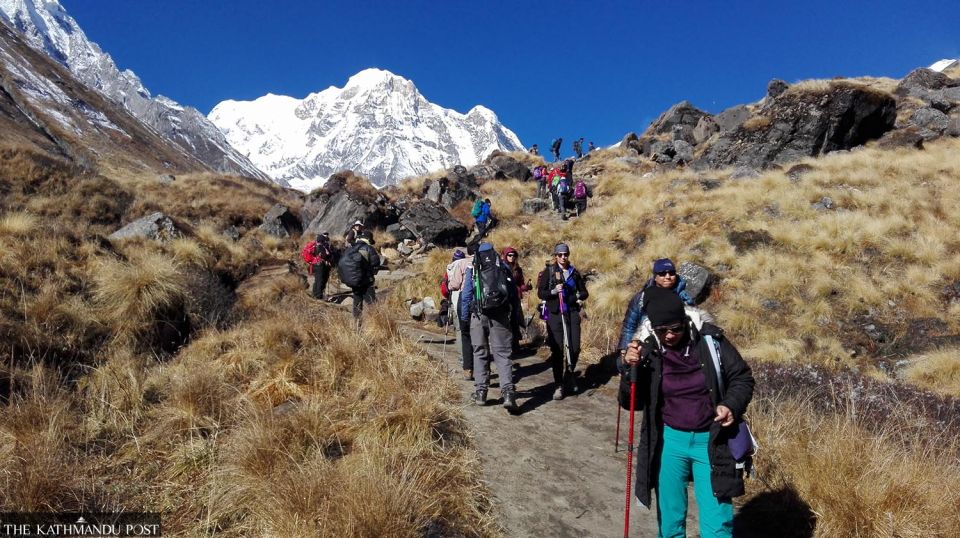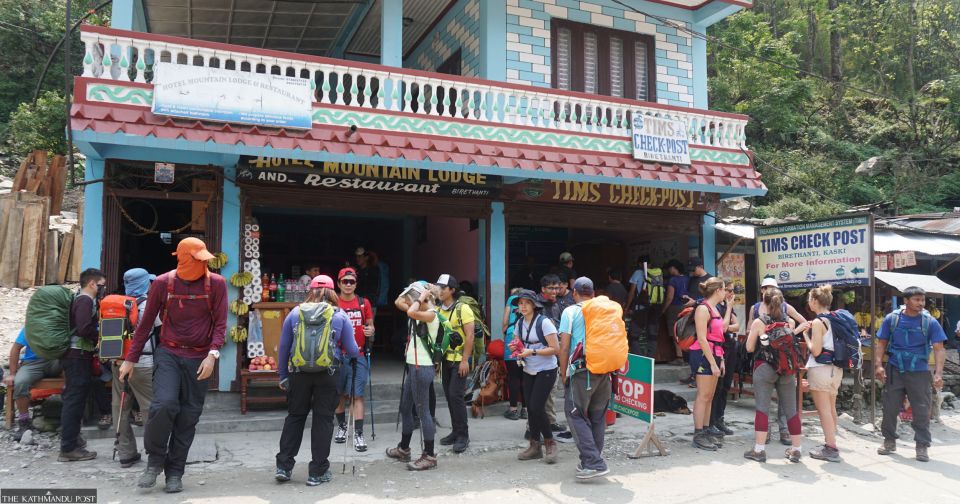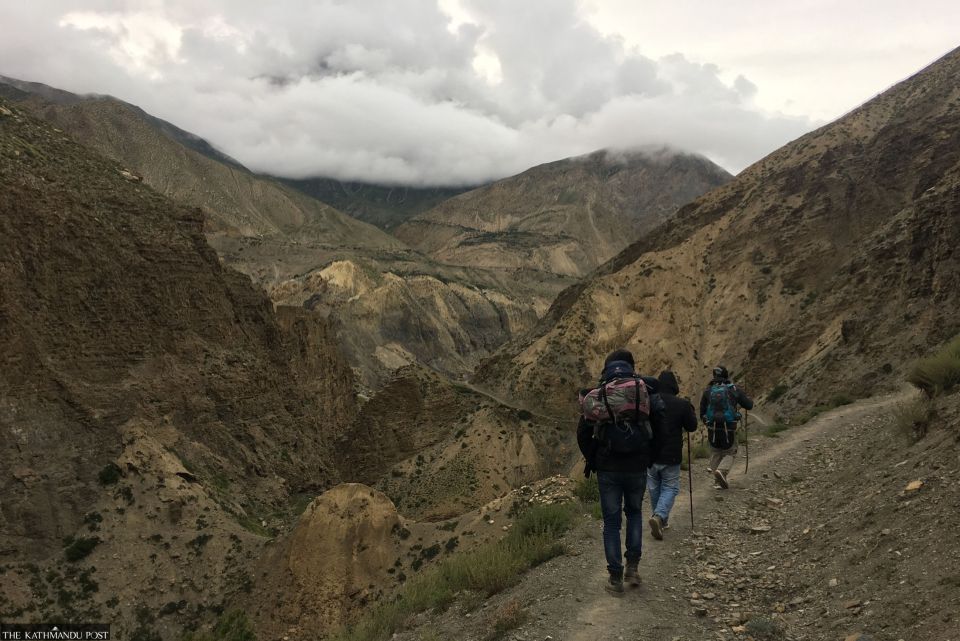Decision draws strong reactions on social media from loyal visitors, many of them expressing anger

The days of solo trekking have not ended. At least, not in the Everest region.
On March 2, the Nepal Tourism Board, the country’s tourism promotional body, and 13 travel trekking organisations and trade unions, decided that beginning April 1, individual backpackers would not be allowed to trek the slopes of Nepal’s Himalayas without a guide.
The rule in the Everest region is, however, different.
“In the Everest area, solo trekkers are allowed,” said Mohan Prasad Chapagain, chief administrative officer of the Khumbu Pasang Lhamu Rural Municipality, under whose jurisdiction the Everest region falls.
“The trekkers, however, have to follow our rules.”
According to Chapagain, the rural municipality issues a separate “trek card” to trekkers that costs Rs2,000 per individual.
“We monitor trekkers at four check posts through this card.”
Khumbu Pasang Lhamu Rural Municipality started collecting trek card fees from foreign trekkers since October 2017 by exercising the powers granted by the federal law.
And since January 2008, all foreign trekkers visiting Nepal are required to obtain the trekkers' information management system (TIMS) card jointly issued by the Nepal Tourism Board and the Trekking Agencies Association of Nepal.
Chapagain, however, said the trekkers visiting the Khumbu or Everest region do not need to bring the TIMS cards, which he says is “illegal”.
As per the Intergovernmental Fiscal Arrangement Act 2017, a local government may levy and recover tax and non-tax revenues in accordance with the local law. “The tax raised by the Nepal Tourism Board and non-governmental organisations like the Trekking Agencies Association of Nepal is illegal as per the law.”
“So, the tax or royalty collected through the TIMS cards is naturally illegal.”
 In 2019, before the Covid pandemic struck, Nepal received 1.19 million foreign tourists.
In 2019, before the Covid pandemic struck, Nepal received 1.19 million foreign tourists.
The Annapurna Rural Municipality, which manages a part of the Annapurna trekking areas, said it follows the Nepal Tourism Board's decision that solo trekkers must be accompanied by a registered guide.
Bishnu Bahadur KC, the ward chairperson of the Annapurna Rural Municipality, said they don’t have their own rules regarding the trekkers. “We follow the rules of the Nepal Tourism Board.”
In 2019, before the Covid pandemic struck, Nepal received 1.19 million foreign tourists. Among them, more than 300,000 were trekkers—with the Annapurna area receiving the highest 181,746 trekkers, followed by 57,289 trekkers in the Everest region, according to government statistics.
Nandini Lahe Thapa, senior director of the Nepal Tourism Board, said her office is working to ensure that the rules for trekkers are uniform across the country.
“The government and the board will come up with a joint statement soon.”
The board decided to make a guide mandatory for solo or free independent trekkers (FITs) citing safety concerns.Some senior tourism entrepreneurs and officials of the board said it has become a habit of the Nepal government to make short-sighted decisions that are often counterproductive, which they later regret.
 Some senior tourism entrepreneurs and officials of the Nepal Tourism Board said it has become a habit of the Nepal government to make short-sighted decisions that are often counterproductive, which they later regret.
Some senior tourism entrepreneurs and officials of the Nepal Tourism Board said it has become a habit of the Nepal government to make short-sighted decisions that are often counterproductive, which they later regret.
But the decision has prompted negative reactions on social media from the loyal and would-be trekkers—with many expressing their annoyance and anger.
Here is what trekkers have to say:
In an email to the Post, Niall Harvey writes, “Shame on you, Nepal Tourism Board (NTB)! Having completed the Annapurna circuit at least 10 times and made over 20 treks in Nepal over the last 20 years, I find this decision nothing more than a desperate final act of greed from NTB.”
Harvey added, “Having visited these places over the last 20 years and watched the changes, way before the roads were put in, the effort to improve the routes and lives of local people has been minimal and unnoticeable.”
Dr Howard Dengate from Australia wrote: “My wife [Sue Dengate] and I have trekked 25 times in Nepal in the last 50 years, the last seven times with camping teams and guides, so that we might explore remote areas. This has provided employment for up to seven people for five weeks each time and hundreds of people have followed our popular track notes, encouraging them to do the same.”
He added: “Clearly, we love Nepal but the latest regulations that force people to take a guide, no matter where they are going or what their level of experience or budget is, are not based on evidence and will be highly counter-productive for tourism.”
Dengate said that increased costs, bureaucracy and the associated hassles will drive many trekkers away. “We are considering whether to ever come to Nepal again, until these foolish regulations are rescinded.”
Another trekking veteran, Victor Bouquet said: “I have been trekking in Népal, as I do in France, in the Alps. I don't think I will travel to Nepal again. I like being my own guide, managing risks. Being like a puppy on a leash, no thank you.”
“Not everyone can afford a guide for a two-week trek. You might lose some diversity among the travellers that come. I love your country, but will probably focus on the north of India for my next trips.”
 The Annapurna Rural Municipality, which manages a part of the Annapurna trekking areas, said it follows the Nepal Tourism Board's decision that solo trekkers must be accompanied by a registered guide.
The Annapurna Rural Municipality, which manages a part of the Annapurna trekking areas, said it follows the Nepal Tourism Board's decision that solo trekkers must be accompanied by a registered guide.
Matt Clancy, country director at Easia Travel for Laos, in a comment on his Facebook page said: “I have a trip planned to Nepal in mid-April, flights booked already, budget agreed. My group is now considering changing destinations. We prefer to travel freely and support local communities in other ways.”
Clancy questioned, “Why is it being done so last minute—why not roll it out in April 2024, so that people who have trips planned a few weeks from now, don't suddenly have to rethink, and re-plan?”
Ben-Erik Ness, communication manager at North Atlantic Seafood Forum, commented: “A hostile move towards tourists...And, the hotels and lodges in Khumbu will take a hit and pay the price.”
Andrey Golovachev posted on Facebook, “Nepal completely bans solo trekking without a local ‘guide’ from April 1, thus completely turning into an over-regulated mountain Disneyland. R.I.P. So glad, I went on a fabulous solo trekking trip in December around the Khumbu region, Sagarmatha national park. Rules of the game change fast these days, so don’t postpone those travels until it's too late!”
Rohit Shukla tweeted: “For a middle-class adventure lover who is genuinely in love with the mountains, this is a death note to my dreams of being able to trek in Nepal. It's become unaffordable now. Absolutely heartbroken. Trekking was a therapy for me for all the sufferings of life. It's been taken away.”
Twitter user Anjuri Pavan Sai Kumar, who is from Hyderabad, India, wrote: “I planned for Everest Base Camp (EBC) Trek in last week of May and before covering EBC, I thought of visiting a few other cities or towns in Nepal as it'll be my first visit to the country. Now, I'm thinking of dropping the plan and going to another place in India itself or any other country.”
Another Twitter user @sibulpunane said: “This is the greediest short-sighted decision ever made, Nepal has lots of tourism infrastructure and barring a risky trek, this is nonsense. Blatant lobbying and corruption involved in order to feed tourism companies.”










